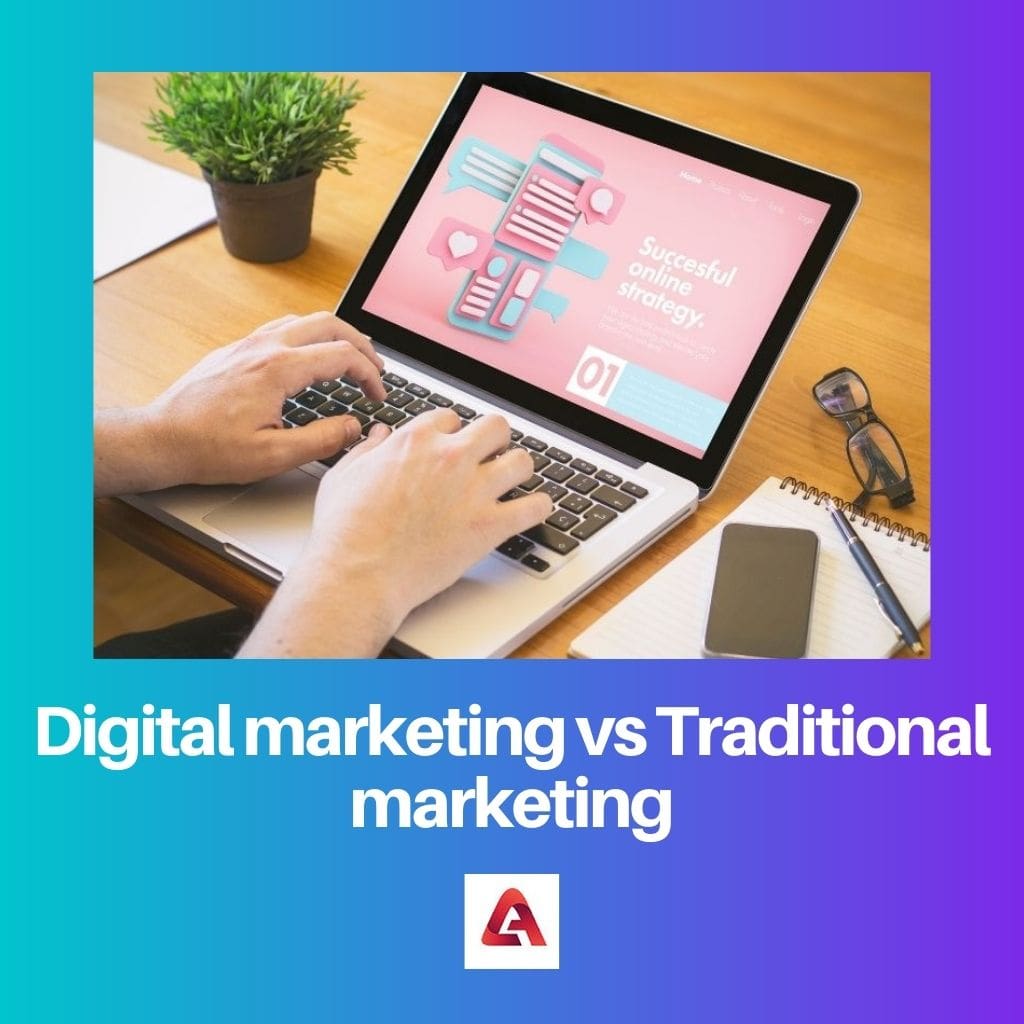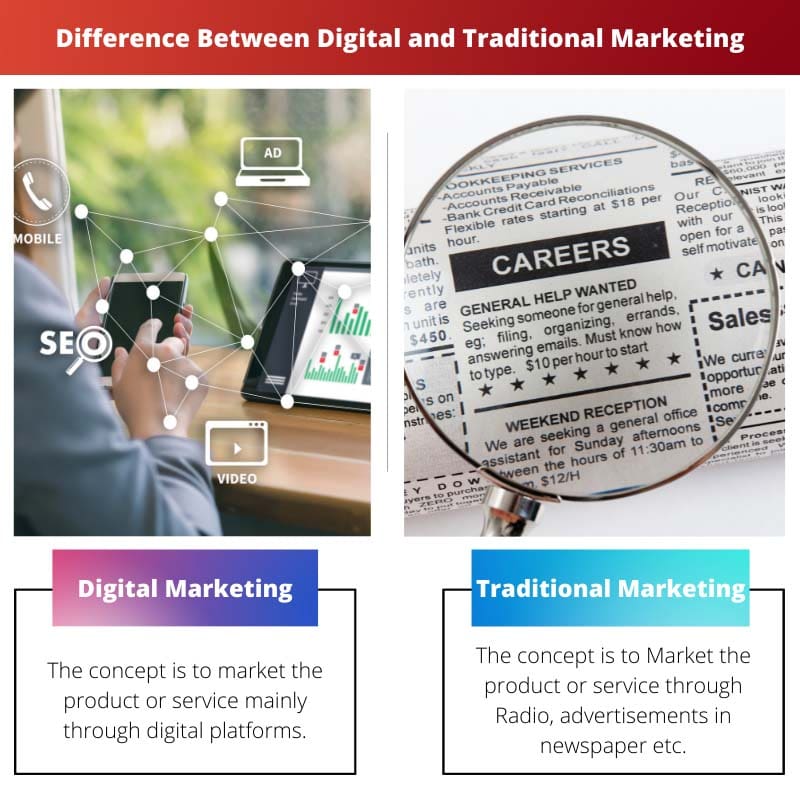Digital marketing leverages online platforms and tools such as social media, email, and search engines to reach and engage target audiences, offering precise targeting, real-time analytics, and cost-effective campaigns. In contrast, traditional marketing relies on offline channels like print, TV, and radio advertisements, providing broad reach but often lacking in measurable ROI and targeting precision.
Key Takeaways
- Digital marketing uses online channels to reach and engage customers; traditional marketing relies on offline methods such as print, TV, and radio advertising.
- Digital marketing offers precise targeting, real-time data, and cost-effective strategies; traditional marketing tends to be more expensive and harder to measure.
- Both digital and traditional marketing can be used to build brand awareness and drive sales, but digital marketing allows for more flexibility, personalization, and adaptability to changing consumer behaviors.
Digital Marketing vs Traditional Marketing
The difference between Digital Marketing and Traditional Marketing is that Digital Marketing focuses on marketing through digital platforms, whereas Traditional Marketing focuses on marketing through old media.

Digital Marketing is promoting services or products of a particular brand through various digital platforms and Social Media platforms. Products and services are marketed through multiple approaches like E-mail, SMS, and marketing on Facebook and Instagram.
Traditional Marketing is marketing through conventional ways like distributing pamphlets, advertisements on television, an announcement on speakers or radio to inform people about their product or service even marketing through cold calls.
Comparison Table
| Feature | Digital Marketing | Traditional Marketing |
|---|---|---|
| Reach | Global | Local or regional |
| Cost | Potentially lower, free options available | Generally higher |
| Measurability | Highly measurable (data readily available) | Difficult to measure accurately |
| Communication | Two-way (allows for interaction with audience) | One-way (limited interaction) |
| Targeting | Highly targeted (based on demographics, interests, etc.) | Limited targeting options |
| Adaptability | Highly adaptable and flexible | Less adaptable, changes take time |
| Engagement | Can create high engagement through interactive elements | Limited engagement opportunities |
| Examples | Search engine optimization (SEO), social media marketing, email marketing | Print advertising, television commercials, billboard |
What is Digital Marketing?
Introduction to Digital Marketing
Digital marketing refers to the practice of promoting products, services, or brands using digital channels and technologies. It encompasses various online platforms and techniques to connect with potential customers, engage them, and ultimately drive sales and brand awareness.
Components of Digital Marketing
- Search Engine Optimization (SEO): SEO involves optimizing a website to improve its visibility and ranking on search engine results pages (SERPs). This is achieved through strategies such as keyword research, content optimization, link building, and technical enhancements, aiming to attract organic traffic and enhance online presence.
- Content Marketing: Content marketing focuses on creating and distributing valuable, relevant, and consistent content to attract and retain a clearly defined audience. This content can take various forms, including blog posts, articles, videos, infographics, and podcasts, with the goal of building brand authority, driving traffic, and nurturing leads.
- Social Media Marketing (SMM): SMM involves leveraging social media platforms like Facebook, Instagram, Twitter, LinkedIn, and others to connect with audiences, build relationships, and promote products or services. Strategies may include organic posting, paid advertising, influencer partnerships, and community engagement to increase brand visibility, engagement, and conversions.
- Email Marketing: Email marketing entails sending targeted messages and promotional content to a list of subscribers via email. This approach aims to nurture leads, maintain customer relationships, and drive conversions by delivering personalized and relevant content, offers, and updates directly to recipients’ inboxes.
- Pay-Per-Click (PPC) Advertising: PPC advertising allows advertisers to display ads on search engines, social media platforms, and other websites and pay a fee each time a user clicks on their ad. Platforms like Google Ads and Facebook Ads offer sophisticated targeting options, budget control, and performance tracking, enabling businesses to reach their ideal audience and drive immediate traffic and conversions.
- Analytics and Data-driven Insights: Analytics tools and platforms provide valuable insights into digital marketing performance, including website traffic, user behavior, campaign effectiveness, conversion rates, and return on investment (ROI). By analyzing these data, marketers can optimize their strategies, allocate resources effectively, and make informed decisions to achieve their business objectives.

What is Traditional Marketing?
Channels of Traditional Marketing
Print Media: Print media includes newspapers, magazines, brochures, flyers, and posters. Advertisers utilize these mediums to display their messages to readers or viewers. Although print circulation has declined with the rise of digital media, it still holds sway in specific markets and demographics.
Television Advertising: Television commercials have been a staple of traditional marketing, offering a visually engaging platform to showcase products or services to a large audience. Advertisers negotiate airtime slots during popular programs or events to maximize exposure, albeit at a considerable cost.
Radio Advertising: Radio advertisements reach listeners through broadcasts on AM, FM, or digital radio stations. Advertisers craft audio messages to capture attention and promote their offerings. Radio advertising can be effective in targeting local audiences or specific demographics based on station formats.
Direct Mail Marketing: Direct mail involves sending physical promotional materials such as postcards, catalogs, or letters directly to consumers’ mailboxes. While it can be costly compared to digital alternatives, direct mail allows for personalized communication and can effectively target specific geographic areas or customer segments.
Outdoor Advertising: Billboards, transit ads, and other outdoor displays serve as prominent fixtures in traditional marketing. Placed strategically in high-traffic areas, these advertisements aim to capture the attention of pedestrians, commuters, and motorists, providing widespread visibility for brands or messages.

Main Differences Between Digital Marketing and Traditional Marketing
- Here are the main differences between digital marketing and traditional marketing:
- Digital Marketing:
- Platform: Primarily conducted on online platforms such as websites, social media, search engines, email, and mobile apps.
- Targeting: Offers precise targeting options based on demographics, interests, behaviors, and other factors, allowing marketers to reach specific audiences.
- Interactivity: Provides opportunities for two-way communication between businesses and customers through comments, likes, shares, reviews, and direct messaging.
- Here are the main differences between digital marketing and traditional marketing:
- Digital Marketing:
- Platform: Primarily conducted on online platforms such as websites, social media, search engines, email, and mobile apps.
- Targeting: Offers precise targeting options based on demographics, interests, behaviors, and other factors, allowing marketers to reach specific audiences.
- Interactivity: Provides opportunities for two-way communication between businesses and customers through comments, likes, shares, reviews, and direct messaging.
- Analytics: Enables real-time tracking and analysis of campaign performance metrics such as impressions, clicks, conversions, and return on investment (ROI).
- Cost-effectiveness: Typically offers lower costs compared to traditional marketing channels, with options for flexible budget allocation and pay-per-click models.
- Traditional Marketing:
- Channels: Relies on traditional offline channels such as television, radio, newspapers, magazines, billboards, direct mail, and events.
- Broad Reach: Offers wide exposure to mass audiences, making it suitable for building brand awareness on a large scale.
- Limited Targeting: Provides limited targeting options compared to digital marketing, often relying on broad demographic segments or geographic regions.
- One-way Communication: Typically involves one-way communication from the business to the audience, with limited opportunities for immediate feedback or interaction.
- Limited Analytics: Offers limited insights into campaign performance, with less ability to track and measure metrics compared to digital marketing.
- Higher Costs: Generally involves higher costs for production, distribution, and placement of advertisements, with less flexibility in budget allocation.
- Analytics: Enables real-time tracking and analysis of campaign performance metrics such as impressions, clicks, conversions, and return on investment (ROI).
- Cost-effectiveness: Typically offers lower costs compared to traditional marketing channels, with options for flexible budget allocation and pay-per-click models.
- Traditional Marketing:
- Channels: Relies on traditional offline channels such as television, radio, newspapers, magazines, billboards, direct mail, and events.
- Broad Reach: Offers wide exposure to mass audiences, making it suitable for building brand awareness on a large scale.
- Limited Targeting: Provides limited targeting options compared to digital marketing, often relying on broad demographic segments or geographic regions.
- One-way Communication: Typically involves one-way communication from the business to the audience, with limited opportunities for immediate feedback or interaction.
- Limited Analytics: Offers limited insights into campaign performance, with less ability to track and measure metrics compared to digital marketing.
- Higher Costs: Generally involves higher costs for production, distribution, and placement of advertisements, with less flexibility in budget allocation.

- https://journalofbusiness.org/index.php/GJMBR/article/download/2049/1951
- https://shop.tarjomeplus.com/UploadFileEn/TPLUS_EN_3080.pdf

The detailed analysis of cost, targeted audience, and advantages vs. disadvantages provides a strong case for digital marketing’s supremacy. Well-argued points.
The breakdown of concepts and real-world implications makes it clear why digital marketing is taking the lead in today’s marketing landscape.
Indeed. The comparisons really highlight the strengths of digital marketing and the limitations of sticking to traditional approaches.
Excellent comparison between digital and traditional marketing. It’s clear how cost-effective and powerful digital marketing can be compared to traditional methods.
Yes, digital marketing offers much more flexibility in reaching a wider audience and precision targeting. Traditional marketing seems outdated in comparison.
The contrast between digital and traditional marketing is made crystal clear. There’s no doubt that digital marketing’s reach and flexibility are unmatched.
Agreed. This piece effectively showcases why traditional marketing is becoming increasingly outdated in today’s digital world.
The way digital marketing is presented as a highly adaptable and cost-effective alternative to traditional methods is truly eye-opening.
The informative and detailed analysis of digital and traditional marketing is on point. Digital marketing’s adaptability and cost-efficiency stand out from this comparison.
Absolutely. Digital marketing seems to hold the key to reaching modern consumers effectively while being mindful of costs.
The thorough comparison between digital and traditional marketing provides a compelling argument for why digital marketing is the future. Great insights.
Absolutely. The analysis offers a clear view of why digital marketing is now the driving force behind successful campaigns.
The comprehensive comparison between digital and traditional marketing is enlightening. It’s clear that digital marketing’s adaptability and cost-efficiency set it apart from traditional methods.
The breakdown of concepts and their real-world implications presents a compelling case for choosing digital marketing over traditional routes.
Absolutely. The comparison effectively highlights why digital marketing is now the go-to method for reaching and engaging audiences.
The detailed comparison makes it evident that digital marketing offers a competitive edge over traditional methods. Excellent insights into the evolution of marketing.
Agreed. This analysis highlights how modern consumer preferences and technological advancements have propelled digital marketing to the forefront.
The article brilliantly highlights the advantages and disadvantages of digital and traditional marketing. It’s interesting to see how digital marketing is more cost-efficient and precise in targeting.
Indeed. The comparison makes it evident that traditional marketing’s higher costs and lower precision are significant drawbacks in today’s digital age.
I appreciate the breakdown of the concept, audience, cost, advantages, and disadvantages between digital and traditional marketing. Very informative and well-structured.
Absolutely. This analysis really showcases the benefits of digital marketing and the potential drawbacks of sticking to traditional methods.
The article did a great job of explaining the differences between digital and traditional marketing. It’s evident how digital marketing is adapted to modern consumer behaviors, leaving traditional methods behind.
The breakdown of concepts and the pros and cons of both methods gives a clear picture of why digital marketing is the way forward.
Agreed. The comprehensive take on the topic really shows the superiority of digital marketing in today’s fast-paced, technology-driven world.